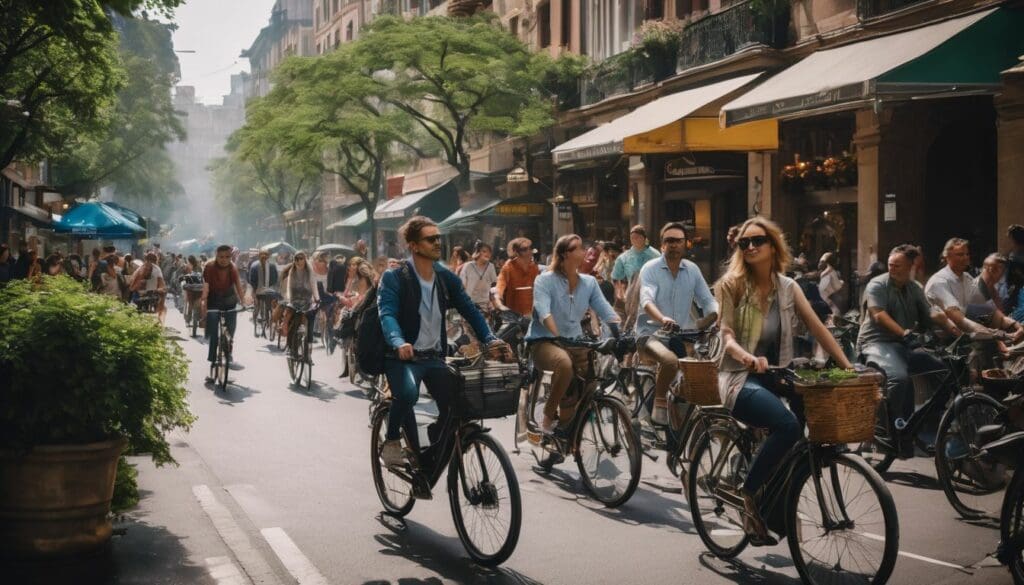Every day greets us with the familiar tableau of bumper-to-bumper vehicles and the relentless drone of city life. Just like you, we’ve felt the heavy burden of concerns over air quality – it’s something that sits on our shoulders like a London fog.
In delving for substantive solutions, we’ve crafted this guide to help bring about a Car-Free Day in your local community, infusing our thoroughfares with a fresh vibrancy. Prepare to witness our roads reborn as spaces of unity and connection!
Key Takeaways
- Engage with your community to create a shared vision for Car – Free Day, involving local businesses and residents in the planning process.
- Promote alternative transport options like cycling, walking, and public transit to reduce reliance on cars and lower pollution levels.
- Organise vibrant activities such as street performances, yoga sessions, or food markets to foster community spirit on a car-free day.
- Post – event analysis is essential—evaluate air quality changes and get feedback from participants to measure success and inform future events.
- Use the momentum of Car – Free Day to advocate for lasting changes such as permanent pedestrian zones or improved cycling infrastructure.
Why Organising a Car-Free Day is Important
Organising a Car-Free Day is important for reducing pollution and car-related emissions, promoting active and sustainable modes of transportation, and creating a sense of community.
It also helps to raise environmental awareness and reduce traffic congestion in our neighbourhoods.
Reduce pollution and car-related emissions
Every time we choose to leave our cars at home, we make a positive impact on air quality. A Car-Free Day encourages us all to cut down on the pollutants that vehicles release into the atmosphere.
These emissions contribute significantly to smog, acid rain and climate change. By reducing our reliance on cars even for one day, we show commitment to cleaner air and a healthier environment.
Imagine streets free of exhaust fumes where kids can play safely and adults can breathe easier. Our community has the power to bring this vision to life by celebrating Car-Free Day.
We support public transportation, cycling, walking—any alternative that keeps cars off our roads helps reduce pollution. Together, let’s take this step towards creating a more sustainable city with fresher air for everyone.
Promote active and sustainable modes of transportation
To further reduce pollution and car-related emissions, promoting active and sustainable modes of transport is crucial. Encouraging walking, cycling, carpooling, and the use of public transport not only decreases carbon emissions but also fosters a healthier lifestyle for individuals in the community.
By advocating for pedestrian-friendly spaces and supporting initiatives like car-free days, we can contribute to reducing traffic congestion while positively impacting air quality.
Embracing green initiatives such as electric vehicles and promoting active transport options play a vital role in creating a more environmentally friendly and sustainable community.
Create a sense of community
To foster a sense of community, we can organise group activities and events during the car-free day, such as street performances, community yoga sessions, or local food markets. Encouraging residents to participate in these activities can help build connections and strengthen the bonds within the neighbourhood.
Collaborating with local businesses and residents to contribute ideas for the event will also enhance a feeling of shared ownership and pride in creating a more sustainable and vibrant community.
Incorporating green spaces into the car-free day programme is another way to create a stronger sense of community. Transforming streets into pedestrian-friendly areas with temporary gardens or seating arrangements encourages people to come together, relax, socialise, and enjoy their surroundings.
This approach not only reduces traffic congestion but also promotes community interaction while adding an eco-friendly touch to the event.
How to Plan and Prepare for a Car-Free Day
To plan and prepare for a car-free day, it’s important to identify potential locations for the event, involve and consult with local businesses and residents, and spread the word to promote community participation.
This will help ensure a successful and well-attended event that promotes sustainable transportation options.
Identify potential locations for a car-free event
When selecting potential locations for a car-free event, we should look for areas with minimal disruption to traffic flow. Seek out spaces that can accommodate pedestrian activities, such as parks, town squares, or closed-off streets.
Consider choosing locations close to public transportation hubs to encourage the use of alternative modes of travel.
Look out for spots where local businesses and residents can benefit from increased foot traffic and engagement. Keep in mind the accessibility and safety of the chosen area, ensuring that it offers enough space for various activities while creating a vibrant atmosphere for the community to come together.
Involve and consult with local businesses and residents
When organising a car-free day, involving and consulting with local businesses and residents is crucial. Here’s how to go about it:
- Meet with local business owners to discuss the potential impact of a car-free day on their operations and how they can participate in the event.
- Collaborate with community leaders and neighbourhood councils to gather input and address any concerns or suggestions regarding the car-free initiative.
- Engage residents through surveys, meetings, or social media platforms to gauge interest, gather ideas for activities, and address any potential challenges.
- Encourage local businesses to offer special promotions or discounts to incentivise participation in the car-free event.
- Seek partnerships with local organisations and advocacy groups that align with the goals of promoting sustainable transportation options and reducing car dependency in the community.
Spread the word and promote the event
After involving and consulting with local businesses and residents, it’s crucial to spread the word and promote the event to maximise community engagement and participation. Here are some important steps to effectively promote a car-free day in your community:
- Utilise social media platforms such as Facebook, Twitter, and Instagram to create event pages and share engaging posts about the benefits of a car-free day. Encourage people to join and share the event with their network.
- Design eye – catching posters and flyers to display in local shops, community centres, and public spaces. Include key details about the event, its purpose, and how individuals can get involved.
- Reach out to local news outlets, radio stations, and community newsletters. Pitch the event as a positive initiative that benefits both the environment and community well-being.
- Collaborate with schools, workplaces, and local organisations to spread awareness about the car – free day through internal communications channels such as newsletters, bulletin boards, or staff meetings.
- Host informational sessions or workshops where participants can learn more about the environmental impact of car usage and how they can contribute to creating a greener, more sustainable community.
- Consider partnering with eco – friendly businesses or sponsors who can help promote the event through their customer networks or by offering incentives for participation.
- Engage with influencers or environmental advocates who can endorse the event on their platforms, helping to reach a wider audience of like-minded individuals.
Setting Up the Event
Create a pop-up car-free zone, provide alternative modes of transportation and organise activities and events to make the day enjoyable for all. Read on to learn more about how you can plan a successful car-free day in your community.
Create a pop-up car-free zone
To create a pop-up car-free zone, we need to identify suitable locations within the community. We can repurpose streets, car parks, or public spaces for this purpose. By setting up barricades and signage, we can clearly mark the area as car-free for a designated period of time.
It’s essential to work closely with local authorities to obtain necessary permits and ensure safety measures are in place.
Once the location is secured, we should consider providing alternative transportation options such as bike rentals or shuttles from nearby car parks. Additionally, organising engaging activities like street performances or interactive workshops will encourage community members to participate in the event and enjoy the benefits of a car-free environment.
Provide alternative modes of transportation
To reduce reliance on cars and promote sustainable transportation, we can provide alternative modes of transportation for a car-free day. This will encourage environmentally conscious individuals to support conservation efforts and embrace eco-friendly travel options. Here are the alternative modes of transportation:
- Arrange shuttle services to transport people around the car-free area, reducing the need for individual cars.
- Set up a bike – sharing or rental system to enable community members to cycle instead of driving.
- Work with public transport authorities to increase the frequency and accessibility of buses and trains on the car-free day.
- Promote walking by creating safe and attractive pedestrian routes, encouraging people to leave their cars at home.
- Collaborate with local businesses to offer incentives or discounts for those who use eco-friendly transportation methods on the car-free day.
- Provide information about electric vehicles and facilitate demonstrations or test drives to showcase sustainable transport options.
Organize activities and events
To create an engaging car-free day event, we can:
- Arrange a bike parade, promoting cycling and showcasing the benefits of sustainable transport.
- Host a community yoga session or fitness classes to encourage physical activity within the car-free zone.
- Organise live music or performances, adding vibrancy and entertainment to the event.
- Set up workshops on eco – friendly practices, focusing on reducing environmental impact in daily life.
- Arrange guided nature walks or tours highlighting the local area’s natural beauty and history.
Follow-up and Future Initiatives
After the successful car-free day event, it’s important to evaluate its impact and encourage continued use of sustainable transportation options. Additionally, we can advocate for more permanent car-free policies and infrastructure in our communities.
Evaluate the success of the event
To measure the success of our car-free day, we’ll collect data on air quality and traffic flow before, during, and after the event. We’ll also conduct surveys to gather feedback from participants on their experience and whether they were inspired to continue using alternative transportation methods.
Analysis of this information will provide valuable insights into the impact of the event on reducing pollution, promoting sustainable transport, and fostering a sense of community.
Additionally, we can assess media coverage and social media engagement to gauge public interest in future initiatives for car-free communities.
Encouraging continued use of sustainable transportation options is key to building on the success of our car-free day. By providing ongoing support and resources for cycling, walking, or using public transport, we aim to create lasting changes in travel habits within our community.
Encourage continued use of sustainable transportation options
Following the success of our car-free event, we aim to sustain momentum by promoting ongoing use of sustainable transportation options. This involves actively advocating for walking, cycling, and public transit as viable modes of daily travel.
By reducing our reliance on cars, we can contribute to a significant decrease in air pollution and traffic congestion while creating pedestrian-friendly spaces within our community.
Promoting the continuous use of alternative transportation methods also aligns with our goal to encourage long-term behaviour change that supports conservation efforts and reduces carbon emissions.
Advocate for more permanent car-free policies and infrastructure.
We should actively push for the implementation of long-term car-free policies and the development of sustainable infrastructure in our communities. This includes advocating for pedestrian-friendly spaces, dedicated cycling lanes, and efficient public transportation systems.
By lobbying for these changes, we can reduce traffic congestion, lower air pollution levels, and encourage more people to choose eco-friendly modes of travel.
Encouraging local authorities and businesses to invest in car-free initiatives will be crucial in creating a cleaner and healthier environment for everyone. It’s vital that we continue pushing for permanent solutions that support our vision of greener, more sustainable communities.
Conclusion
In conclusion, organising a car-free day in your community is crucial for reducing pollution and promoting sustainable transportation. Identifying potential locations, involving local businesses and spreading the word are key to successful planning.
Creating a pop-up car-free zone with alternative transportation options can make the event engaging. Evaluating its success and advocating for more permanent car-free policies ensures long-term impact on traffic congestion and air pollution reduction.
FAQs
1. What is a Car-Free Day?
A Car-Free Day encourages people to leave their cars at home and enjoy spaces usually filled with traffic. It’s about reducing air pollution, creating pedestrian-friendly areas, and promoting cycling and walking.
2. How can we organise a Car-Free Day in our community?
To organise a Car-Free Day, you’ll need to plan activities that support car-free initiatives, get the word out to your community, and set up temporary pop-up zones where traffic is restricted.
3. Why should we participate in World Car Free Day?
Participating in World Car Free Day shows support for reducing congestion on our streets and cutting down on pollution while advocating for healthier modes of transport like cycling or walking.
4. Can schools take part in organising a car-free initiative?
Yes! Schools can host a ‘Car-Free Campus Day’, encouraging students and staff to find alternative ways of getting there without using cars, helping everyone see the benefits of less congested roads around school grounds.





